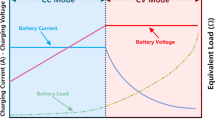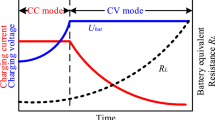Abstract
Inductive power transfer (IPT) technology is widely used in the automobile industry, household electronics, and medical devices because of its numerous advantages. This manuscript proposes a novel hybrid topology for inductive power transfer (IPT) systems, combining the series–series (SS) and inductance–capacitance–capacitance–series (LCC-S) circuitries. The study introduces several key novelties to improve battery charging efficiency and reliability. Firstly, the hybrid topology achieves a load-independent zero phase angle (ZPA) condition at a constant resonant frequency, eliminating the need for frequency variation between constant current (CC) and constant voltage (CV) charging modes by introducing a tunable inductor and an AC switch. That results in simplified control circuit. In addition, it eliminates the need for variable resonant frequency control or coupling coefficient tuning to achieve CC and CV charging operations at a constant resonant frequency. Moreover, the proposed topology extends circuit lifespan and reliability by minimizing the number of capacitors required. Simulation analysis of a 2.4 kW prototype charging system was implemented in PLECS with MATLAB/Simulink to confirm the feasibility and operating performance of the proposed design. According to the results, the proposed topology successfully realizes stable CC and CV charging with ZPA condition at 85 kHz single resonant frequency even under different load conditions. The maximum power of 2.4 kW was achieved with 98.66% efficiency for an equivalent battery load of 67 Ω and a coupling factor of 0.3585. Additionally, a comparison review of CC/CV charging capability, control complexity, and cost-effectiveness between existing circuits and the designed topology are presented in the discussion of this paper.




















Similar content being viewed by others
Data availability
This study did not use any data or materials that are publicly available.
References
Hwang S-H, Chen Y, Zhang H, Lee K-Y, Kim D-H (2020) Reconfigurable hybrid resonant topology for constant current/voltage wireless power transfer of electric vehicles. Electronics 9(8):1323. https://doi.org/10.3390/ELECTRONICS9081323
Y Shou, B Luo, S Xiong, G Zhu, J Lu, JV Wang (2019) “Efficiency Analysis in IPT System Based on LCC Compensation Network,” ICPE 2019 - ECCE Asia-10th International Conference on Power Electronics-ECCE Asia, pp. 2258–2263, 2019, doi: https://doi.org/10.23919/ICPE2019-ECCEASIA42246.2019.8796952.
Ali N, Liu Z, Armghan H, Ahmad I, Hou Y (2021) LCC-S-based integral terminal sliding mode controller for a hybrid energy storage system using a wireless power system. Energies 14(6):1693. https://doi.org/10.3390/EN14061693
M Gholipour, S Farhangi, M Saradarzadeh, E Asadi (2021) “Implementation of Burp Pulse Charging in Inductive Power Transfer Systems with LCC-Series Compensating Topology for Electric Vehicle Charger Application,” 2021 12th Power Electronics, Drive Systems, and Technologies Conference, PEDSTC 2021. doi: https://doi.org/10.1109/PEDSTC52094.2021.9405885.
Li S, Li W, Deng J, Nguyen TD, Mi CC (2015) A double-sided LCC compensation network and its tuning method for wireless power transfer. IEEE Trans Veh Technol 64(6):2261–2273. https://doi.org/10.1109/TVT.2014.2347006
Wang W, Deng J, Chen D, Wang Z, Wang S (2021) A novel design method of LCC-S compensated inductive power transfer system combining constant current and constant voltage mode via frequency switching. IEEE Access. https://doi.org/10.1109/ACCESS.2021.3105103
Zhou S, Chris Mi C (2016) Multi-paralleled LCC reactive power compensation networks and their tuning method for electric vehicle dynamic wireless charging. IEEE Trans Ind Electron 63(10):6546–6556. https://doi.org/10.1109/TIE.2015.2512236
Hannan MA, Hoque MM, Hussain A, Yusof Y, Ker PJ (2018) State-of-the-art and energy management system of lithium-ion batteries in electric vehicle applications: issues and recommendations. IEEE Access 6:19362–19378. https://doi.org/10.1109/ACCESS.2018.2817655
Rehman M, Nallagownden P, Baharudin Z (2020) Design of a new hybrid topology of WPT system to achieve load-independent constant-current and constant-voltage output. Symmetry 12(9):1453. https://doi.org/10.3390/SYM12091453
J Lu, G Zhu, W Li, B Li (2019) “Load-Independent ZPA Conditions in Both Constant Current and Constant Voltage Modes of LCC-Series Compensated IPT System,” 2018 IEEE Wireless Power Transfer Conference, WPTC 2018, Feb. 2019, doi: https://doi.org/10.1109/WPT.2018.8639453.
Yan Z, Zhang Y, Song B, Zhang K, Kan T, Mi C (2019) “An LCC-P compensated wireless power transfer system with a constant current output and reduced receiver size. Energies 12(1):172. https://doi.org/10.3390/EN12010172
Deng J, Li W, Li S, Mi C (2014) “Magnetic integration of LCC compensated resonant converter for inductive power transfer applications.” 2014 IEEE Energy Conversion Congress and Exposition ECCE 2014:660–667. https://doi.org/10.1109/ECCE.2014.6953458
Li S, Mi CC (2015) Wireless power transfer for electric vehicle applications. IEEE J Emerg Sel Top Power Electron 3(1):4–17. https://doi.org/10.1109/JESTPE.2014.2319453
Vu VB, Phan VT, Dahidah M, Pickert V (2019) Multiple output inductive charger for electric vehicles. IEEE Trans Power Electron 34(8):7350–7368. https://doi.org/10.1109/TPEL.2018.2882945
Zhang W, Mi CC (2016) Compensation topologies of high-power wireless power transfer systems. IEEE Trans Veh Technol 65(6):4768–4778. https://doi.org/10.1109/TVT.2015.2454292
Sen Wang C, Stielau OH, Covic GA (2005) Design considerations for a contactless electric vehicle battery charger. IEEE Trans Ind Electron 52(5):1308–13145
Qu X, Han H, Wong SC, Tse CK, Chen W (2015) Hybrid IPT topologies with constant current or constant voltage output for battery charging applications. IEEE Trans Power Electron 30(11):6329–6337. https://doi.org/10.1109/TPEL.2015.2396471
Vu VB, Tran DH, Choi W (2018) Implementation of the constant current and constant voltage charge of inductive power transfer systems with the double-sided LCC compensation topology for electric vehicle battery charge applications. IEEE Trans Power Electron 33(9):7398–7410. https://doi.org/10.1109/TPEL.2017.2766605
Thrimawithana DJ, Madawala UK (2013) A generalized steady-state model for bidirectional ipt systems. IEEE Trans Power Electron 28(10):4681–4689. https://doi.org/10.1109/TPEL.2012.2237416
F. Lu, H. Hofmann, J. Deng, and C. Mi, “Output power and efficiency sensitivity to circuit parameter variations in double-sided LCC-compensated wireless power transfer system,” Conference Proceedings - IEEE Applied Power Electronics Conference and Exposition - APEC, vol. 2015-May, no. May, pp. 597–601, May 2015, doi: https://doi.org/10.1109/APEC.2015.7104410.
Y Zhang, Y Guo, L Wang, Q Bo (2020) “Design of dual-side LCC compensation networks considering rectifier equivalent inductance for wireless power transfer system,”2020 IEEE PELS Workshop on Emerging Technologies: Wireless Power Transfer, WoW 2020, pp. 210–213. https://doi.org/10.1109/WOW47795.2020.9291321.
Fu N, Deng J, Wang Z, Wang W, Wang S (2022) A hybrid mode control strategy for LCC-LCC-compensated WPT system with wide ZVS operation. IEEE Trans Power Electron 37(2):2449–2460. https://doi.org/10.1109/TPEL.2021.3108637
Farajizadeh F, Vilathgamuwa DM, Jayathurathnage P, Ledwich G (2022) Estimation of the transferred power in LCC compensated wireless power transmitters with the use of PWM-synchronized sampling technique. IEEE Trans Transport Electri 8(1):710–722. https://doi.org/10.1109/TTE.2021.3098643
Zhang H, Chen Y, Park SJ, Kim DH (2019) A hybrid compensation topology with single switch for battery charging of inductive power transfer systems. IEEE Access 7:171095–171104. https://doi.org/10.1109/ACCESS.2019.2955805
Chen Y, Zhang H, Park SJ, Kim DH (2019) A switching hybrid LCC-S compensation topology for constant current/voltage EV wireless charging. IEEE Access 7:133924–133935. https://doi.org/10.1109/ACCESS.2019.2941652
Li G, Kim DH (2021) A wireless power transfer charger with hybrid compensation topology for constant current/voltage onboard charging. Appl Sci 11(16):7569. https://doi.org/10.3390/APP11167569
UD Kavimandan VP Galigekere O Onar, M Mohammad, B Ozpineci, SM Mahajan (2021) “The sensitivity analysis of coil misalignment for a 200-kW dynamic wireless power transfer system with an LCC-S and LCC-P compensation,”2021 IEEE Transportation Electrification Conference and Expo, ITEC 2021, pp. 1–8. https://doi.org/10.1109/ITEC51675.2021.9490035.
Chen Y, Zhang H, Park SJ, Kim DH (2019) A Comparative Study of S-S and LCCL-S Compensation Topologies in Inductive Power Transfer Systems for Electric Vehicles. Energies 12(10):1913. https://doi.org/10.3390/EN12101913
Zhu Y, Wu H, Li F, Zhu Y, Pei Y, Liu W (2022) A comparative analysis of S-S and LCCL-S compensation for wireless power transfer with a wide range load variation. Electronics. https://doi.org/10.3390/ELECTRONICS11030420
Zhao Q, Wang A, Liu J, Wang X (2019) The load estimation and power tracking integrated control strategy for dual-sides controlled LCC compensated wireless charging system. IEEE Access 7:75749–75761. https://doi.org/10.1109/ACCESS.2019.2922329
D Medini, S Ben-Yaakov (1994) “A current-controlled variable-inductor for high frequency resonant power circuits,”Conference Proceedings - IEEE Applied Power Electronics Conference and Exposition-APEC, 1:219–225. https://doi.org/10.1109/APEC.1994.316396.
Funding
This study did not receive any funding.
Author information
Authors and Affiliations
Contributions
EK contributed to the study design, performing analysis, interpretation, and manuscript writing—editing. SB contributed to the study design, interpretation, supervision and manuscript editing.
Corresponding author
Ethics declarations
Conflict of interest
The authors declare no competing interests.
Ethical Approval
This study did not involve human or animal subjects, and thus, no ethical approval was required.
Additional information
Publisher's Note
Springer Nature remains neutral with regard to jurisdictional claims in published maps and institutional affiliations.
Rights and permissions
Springer Nature or its licensor (e.g. a society or other partner) holds exclusive rights to this article under a publishing agreement with the author(s) or other rightsholder(s); author self-archiving of the accepted manuscript version of this article is solely governed by the terms of such publishing agreement and applicable law.
About this article
Cite this article
Kandemir, E., Borekci, S. LCC-S compensated variable inductor-based hybrid topology analysis for inductive power transfer system. Electr Eng 106, 1585–1604 (2024). https://doi.org/10.1007/s00202-023-02014-y
Received:
Accepted:
Published:
Issue Date:
DOI: https://doi.org/10.1007/s00202-023-02014-y




